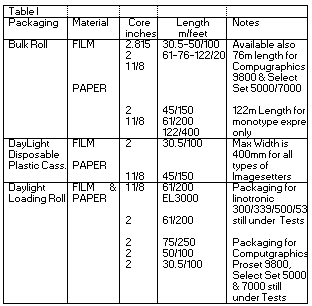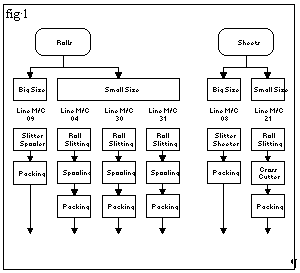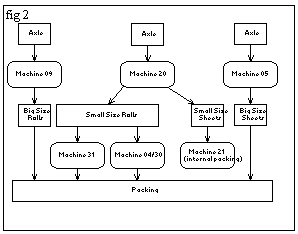This simulation project was developed as a result of a production scheduling problem: the plant in question can manufacture a wide range of products (table I)

under strict delivery deadlines, while some of the machines used are obsolete. In practice, the favorable market condition has terminated and thus the production plant has become a critical factor with respect to the evolution of demand.
To successfully tackle this problem, it was decided to produce a realistic model of the production process on which to test different scheduling methods and to optimize them, if possible, using Knowledge_Based Systems (KBS).
The tool was particularly interesting already from the initial development phase, since it was possible to study other aspects of the production process. It was decided to postpone the development of a scheduler to first perform an in_depth analysis of the plant. Before working directly with scheduling, the necessary guidelines were established to improve the quality of the product from a plant engineering point of view, replacing obsolete components with those which are more economically/technically up_to_date. This plant has a rather complex production flow: different management solutions often can be used to manufacture the same product without affecting the sequence of the orders (fig. 1).

The first area of the general layout consists of two machines: one that performs processing operations independently and the other that only prepares the rolls. This second machine performs retooling and resetting operations faster, therefore it is more suitable for continuous changes in product types (fig. 2).

Three other machines are installed after the first two units. These are designed to complete the roll production process and to package the product in the required format; each of these machines works on a particular type of photosensitive film.
The plant is also equipped with two special machines to process specific films (sensitive to particular frequencies such as infra_red, X_rays, etc.). These machines are installed in departments which are adequately shielded against light.
In fact, each machine is located in the plant in its own specific room and production is carried out in a green light environment; for special production processes the work is even carried out in total darkness (blind personnel are employed to work in these areas).
Therefore, the reduced lighting conditions have a major effect on machine operating times to compensate for stoppages or to change settings, thus leading to a major deviations from the rated data supplied for the different machines. This means that precise data acquisition procedures must be performed directly on the plant to determine these values. The product packing area is located after this production unit. Since this area must prepare many different types of products, a large percentage of the work is performed manually.
Workers perform a quality control check at the end of each process. If the product does not pass this check, the order corresponding to that lot must still be completed. The "rejected" product follows alternative production routes which still guarantee that it will be marketed.
Plant production is performed by lots. For modeling purposes, it was necessary to identify the correct arrival frequencies of the orders for each type of product. This was achieved by performing a statistical analysis on the available historical data.
In this operating situation, the different lots normally follow different production cycles through specific sequences; in fact, at this time, the more obsolete machine (the one that can independently complete the production cycle) is used for the large production orders, thus limiting retooling and setting operations and thus reducing dead time. Instead, the more modern machine is used to handle the smaller yet more numerous lots.
As already mentioned, the products handled by the second machine must still be processed by other machines, and such processing varies depending on the type of product. In this case, it is again possible to select different machines since there is a certain amount of overlapping between the respective production capacities. As a general rule, there is a tendency to implement the concept described above which aims at reducing retooling operations on the obsolete machines, thus directing the lots with large quantities to the machine that requires more preparation time, and allocating the smaller lots to the more modern machines.
The analysis performed indicated that the final part of the plant, the packing area, was very critical: this is because there are many different types of packages with distinct preparation times, often quite long, which generate a discontinuity in production capacity. At the same time, there has been a major reduction in personnel assigned to the area compared to real need. Based on these facts, the packing department required a detailed model to determine the action to be taken to improve this area.
Therefore, it was decided to build a special detail simulator rather than use traditional techniques, such as the queue theory or linear programming. The system used was unsuitable for these methods due to the complex interactions between the factors involved in the production process (sharing skilled personnel between different departments, the need for synchronization between different base components of the products, etc.). This observation was also supported by plant personnel who in fact were looking for an analysis tool since the traditional techniques they used were inefficient.